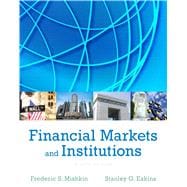For all undergraduate and graduate students of Financial Markets. This title is also suitable for all readers interested in financial markets and institutions.
A practical and current look into today’s financial markets and institutions.
In Financial Markets and Institutions , bestselling authors Frederic S. Mishkin and Stanley G. Eakins provide a practical introduction to prepare students for today’s changing landscape of financial markets and institutions.
A unifying framework uses core principles to organize students’ thinking then examines the models as real-world scenarios from a practitioner’s perspective. By analyzing these applications, students develop the critical-thinking and problem-solving skills necessary to respond to challenging situations in their future careers. Although this text has undergone a major revision, the Eighth Edition retains Mishkin/Eakins’ hallmark pedagogy that make it the best-selling textbook on financial markets and institutions.
This program will provide a better teaching and learning experience–for you and your students. Here’s how:
- Organize Learning with a Unifying Analytic Framework: Core principles organize students’ thinking and then examine the models as real-world scenarios from a practitioner’s perspective.
- Help Students Transition from Classroom to Career with Real-Life Business Scenarios: Cases increase students’ interest by applying theory to real-world data and examples.
- Emphasis Critical Thinking with Key Features : Examples and exercises allow students to put into practice the concepts that they are learning.
- Keep Your Course Current and Relevant: New material on financial markets and institutions and monetary policy appear throughout the text.








